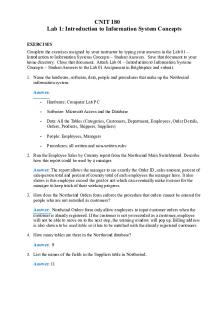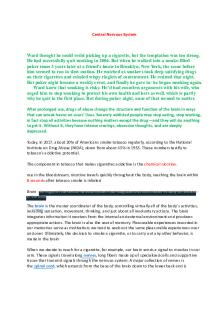Unit 12 intro to nervous system PDF

| Title | Unit 12 intro to nervous system |
|---|---|
| Course | Anatomy and Physiology I |
| Institution | California State University East Bay |
| Pages | 3 |
| File Size | 234.9 KB |
| File Type | |
| Total Downloads | 24 |
| Total Views | 143 |
Summary
Lab Assignment...
Description
Name Section
Date
UNIT
12 REVIEW
Check Your Recall 1
Label the following structures on Figure 12.9. ❑ Axon ❑ Axon collateral ❑ Axon hillock
Nissl bodies
❑ Cell body ❑ Dendrites ❑ Neurofibrils
❑ Nissl bodies ❑ Telodendria
Axon collateral Neurofibr ils Axon Axon hillock
Telodendria
Cell body Dendrites FIGURE
2
12.9
Neuron.
The neuron pictured in Figure 12.9 is a a. pseudounipolar neuron. b. bipolar neuron. c. multipolar neuron. d. unipolar neuron.
Introduction to the Nervous System ❘
UNIT
12 ❙ 5
3
The main function of an axon is to a. generate EPSPs or IPSPs when neurotransmitters bind their membranes. b. generate and transmit signals in the form of action potentials. c. function as the biosynthetic center of the neuron. d. form the myelin sheath.
4
Where are synaptic vesicles located? a. Axon terminals. b. Dendrites. c. Cell body. d. Both a and b are correct. e. All of the above.
5
Matching: Match the neuroglial cell with its correct function.
6
__F__ Oligodendrocytes
A. Create the myelin sheath in the PNS
__D__ Astrocytes
B. Ciliated cells in the CNS that form and circulate cerebrospinal fluid
__E__ Microglial cells
C. Surround the cell bodies of neurons in the PNS
__A__ Schwann cells
D. Anchor neurons and blood vessels, maintain extracellular environment around neurons, assist in the formation of the blood-brain barrier
__C__ Satellite cells
E. Phagocytic cells of the CNS
__B__ Ependymal cells
F. Form the myelin sheath in the CNS
Label the following structures on Figure 12.10. ❑ Internode ❑ Myelin
❑ Neurilemma ❑ Node of Ranvier
❑ Oligodendrocyte ❑ Schwann cell
Oligodendrocyte Schwann cell
Internode Myelin Node of Ranvier
Neurilemma
FIGURE
12.10
Myelin sheath.
Introduction to the Nervous System ❘
UNIT
12 ❙ 6
7
Label the following structures on Figure 12.11. ❑ Axon terminal of presynaptic neuron ❑ Neurotransmitter receptors
❑ Neurotransmitters ❑ Postsynaptic neuron ❑ Synaptic cleft
Synapt ic vesicle
❑ Synaptic vesicles ❑ Voltage-gated Ca2! channel
Voltage-gated calcium ion channel
Neur otransmitters
Axon terminal of presynaptic neuron
Synaptic cleft Neur otransmitter receptor Postsynaptic neuron
FIGURE
12.11
Structure of a neuronal synapse.
8
An action potential is generated at the a. trigger zone of the axon. b. postsynaptic membrane. c. cell body. d. axon terminal.
9
What is the difference between an excitatory postsynaptic potential and an inhibitory postsynaptic potential?
An excitatory postsynaptic potential creates a local depolarization in the membrane of the postsynaptic neuron that brings it closer to threshold. An inhibitor postsynaptic potential does the opposite; it hyperpolarizes the membrane and brings it farther away from threshold.
10
What triggers exocytosis of synaptic vesicles? a. Arrival of a local potential at the cell body. b. Hyperpolarization of the postsynaptic membrane. c. Neurotransmitters binding to the postsynaptic membrane. d. The influx of calcium ions into the axon terminal.
Introduction to the Nervous System ❘
UNIT
12 ❙ 7...
Similar Free PDFs

Unit 12 intro to nervous system
- 3 Pages

Chapter 12 - Nervous System
- 62 Pages

Unit 7 intro to skeletal system
- 2 Pages

Chapter 12 quiz - Nervous system
- 1 Pages

Nervous system
- 15 Pages

Nervous system
- 14 Pages

Nervous System
- 4 Pages

Lab 01- intro to system
- 2 Pages

Unit 1 Intro to Bio
- 2 Pages

Unit 2 Intro to Biology
- 5 Pages

Chapter 9 - Nervous System
- 7 Pages

CH15+Autonomic+Nervous+System
- 6 Pages

Ch 5 Nervous System
- 12 Pages

Central Nervous System
- 5 Pages
Popular Institutions
- Tinajero National High School - Annex
- Politeknik Caltex Riau
- Yokohama City University
- SGT University
- University of Al-Qadisiyah
- Divine Word College of Vigan
- Techniek College Rotterdam
- Universidade de Santiago
- Universiti Teknologi MARA Cawangan Johor Kampus Pasir Gudang
- Poltekkes Kemenkes Yogyakarta
- Baguio City National High School
- Colegio san marcos
- preparatoria uno
- Centro de Bachillerato Tecnológico Industrial y de Servicios No. 107
- Dalian Maritime University
- Quang Trung Secondary School
- Colegio Tecnológico en Informática
- Corporación Regional de Educación Superior
- Grupo CEDVA
- Dar Al Uloom University
- Centro de Estudios Preuniversitarios de la Universidad Nacional de Ingeniería
- 上智大学
- Aakash International School, Nuna Majara
- San Felipe Neri Catholic School
- Kang Chiao International School - New Taipei City
- Misamis Occidental National High School
- Institución Educativa Escuela Normal Juan Ladrilleros
- Kolehiyo ng Pantukan
- Batanes State College
- Instituto Continental
- Sekolah Menengah Kejuruan Kesehatan Kaltara (Tarakan)
- Colegio de La Inmaculada Concepcion - Cebu

